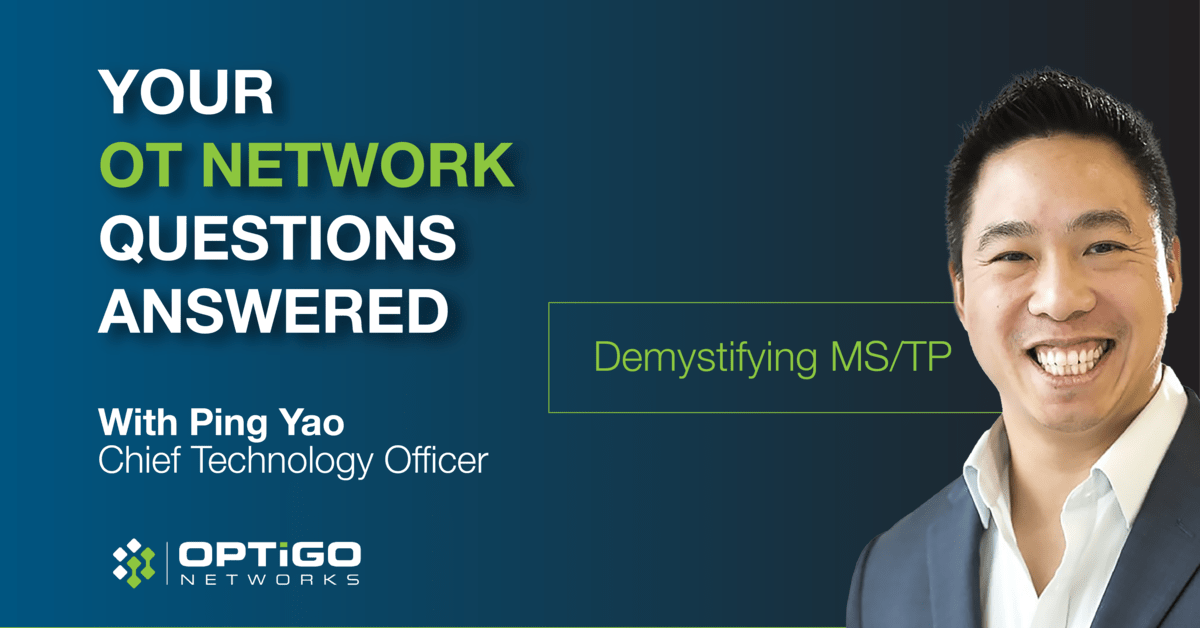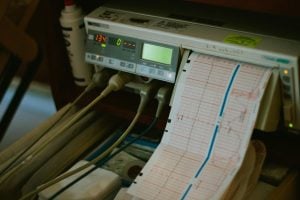Mastering MS/TP. Sounds like an archaic thing to do 2025, but MS/TP BACnet systems are still a lot more common that you’d think, and it’s become increasingly harder to ensure that all that operating knowledge is passed along.
In this episode, we’re tackling your submitted questions on MS/TP. From basic best practices to essential troubleshooting, let’s tackle this protocol together!
We’re back with another episode of answering your BACnet questions! The response to our Q&A series has been incredible – thank you to everyone who submitted their questions about OT networks and BACnet. Our Co-Founder and CTO, Ping-Pook Yao, tackled some excellent questions about BBMDs this time around.
Have more BACnet questions? Keep them coming! We love diving deep into these technical topics that help make OT networks more reliable and efficient. Send us a message on LinkedIn, Reddit, or Bluesky, or email us at marketing@optigo.net .
Q1: How Many Devices Should I Have on an MS/TP Subnet (actually)?
MS/TP can support up to 128 master devices. But according to Ping (and many seasoned pros in the industry), the sweet spot is closer to 25 to 30 devices.
Why? That range strikes the right balance between connectivity and performance. While you can fill the network with more devices, doing so can eat up bandwidth and make your system slower, harder to troubleshoot, and more prone to errors.
As networks grow physically longer, you often need to reduce the baud rate to maintain clean, distinct signals. That trade-off means you may have more devices — but at the cost of speed and efficiency.
Based on real-world troubleshooting cases and network performance, here’s our recommendations:
- Try to keep it well under 32 devices per segment. Optigo recommends 16–20 devices max per segment for stable performance.
- OptigoVN has observed token passing delays, timeouts, and excessive retries in segments that push toward the upper limit—even if technically allowed.
| Scenario | Max Devices (Safe) | Max Devices (Technical) |
|---|---|---|
| No repeaters | 16–20 recommended | 32 max |
| With repeaters (carefully done) | ~100 (real-world cap) | 128 theoretical |
Q2: What’s the Difference Between MS/TP and BACnet/IP?
All lot. Like night and day a lot.
- MS/TP uses half-duplex communication, which means only one device can talk at a time while others listen. BACnet/IP, on the other hand, uses full-duplex communication, so devices can send and receive data at the same time.
- Physical wiring – MS/TP lets you daisy-chain devices over a single cable, which keeps costs low. BACnet/IP, on the other hand, uses distinct Ethernet links for each connection, even if multiple cables are involved.
- Data transmission method – MS/TP is half duplex, meaning only one device can talk at a time. BACnet/IP is full duplex (unless you’re using very old hubs), so devices can send and receive data simultaneously. This alone can double throughput on a BACnet/IP network.
- Speed – BACnet/IP typically runs at a minimum of 10 megabits per second, while MS/TP is in the tens of thousands of bits per second (e.g., 38,400 bps or 76,800 bps). That’s an orders of magnitude difference in speed.
Importantly, just because MS/TP is slower doesn’t mean it’s the root cause of performance issues — problems can come from outside the MS/TP segment.
Q3: My MSTP network is slow. Where do I start looking to fix this?
- Start with a fast isolation test: disconnect the MS/TP segment from other networks.
- If it still underperforms, the problem is local to that MS/TP segment and likely physical.
- If you prefer not to isolate, use an MS/TP capture tool (Ping references a link to an Optigo resource). Look for:
- Checksum errors → packets are likely corrupted.
- Lots of “poll for master / reply to poll for master” → often indicates a lost token.
- If you have access to Optigo Visual Networks, use it to quickly flag checksum issues, lost tokens, or token disruptions. Also remember: when MS/TP is connected to other networks, external effects from the greater system can slow it down—so rule those out too.
Q4: I have a lot of MS/TP “legacy” hardware. How do I get it connected to a modern IP network?
If you already have a BACnet router, enable routing, connect it to the IP network, and you’re done.
Don’t have one yet? Add a BACnet router—there are many options. That’s what lets you interconnect a modern IT network with an MS/TP network cleanly.
Demystifying MS/TP
MS/TP can be challenging to troubleshoot, and excessive broadcast traffic is one of the primary reasons building automation systems underperform. Tools like Optigo Visual Networks can help you analyze broadcast message volume and identify problematic duplicate BBMDs quickly.
Make all your OT network issues a quick fix with OptigoVN. Best in class BACnet diagnostics and advanced contextual results find issues and optimizations across more than 30 different critical tests.
Want to see what OptigoVN can fix for you? There’s never been a better time to get started with the industry’s most powerful OT network diagnostic tool. Sign up for a free trial of OptigoVN today or contact us to schedule a personalized demo and see how our platform can empower your team.
Transcript
Question 1
MSTP, also known as master slave token protocol, as many of you know, can support up to 128 master devices. Based on lots of friends in the industry, we hear the recommendation to be somewhere around 25 to 30. It’s a good balance between the number of devices that can connect without using so much of the bandwidth that pushes you towards a problematic system.
Well, first of all, the system does become quite large to diagnose and troubleshoot. But second, also naturally when you have a lot of devices, the network does tend to physically be longer. You tend to have to drop the baud rate so that the zeros and ones still have clean waveforms. So the zeros are clear zeros, and ones are clear ones. So the compromise of going to a very large network but then dropping the performance — it just doesn’t work out very well.
Do you really want to get into a case where you’re calculating how much bandwidth you have and therefore deciding if you can go to 50, you go to 60? In general, 25 to 30, based on lots of friends in the industry. We hear that’s a good compromise, a good fit.
Question 2:
MS/TP and BACnet/IP is very different. MS/TP does allow you to daisy chain devices using a single physical medium, a single wire basically, and connect lots and lots of devices. This reduces the cost of deploying a physical network in MS/TP. Whereas in BACnet/IP, even if it’s multiple Ethernet cables, there’s still distinct links.
Difference number two: MS/TP is what we call half duplex and BACnet/IP — unless we talk about very very very old hubs — is full duplex. What does that mean? Half duplex means that when one device communicates or talks on the network, no other device can talk. Whereas in BACnet/IP, multiple devices can talk at the same time and they can receive and transmit at the exact same time. Simply by going from one half duplex to full duplex, you double the throughput on that BACnet/IP network.
Now difference number three. As you all know, BACnet/IP — we’re talking about at the minimum ten megabits per second. Whereas in MS/TP we’re talking about 30,000 boards, 38,000 bits, 78,000 bits. If you do the math, it’s not even close. We’ll talk about orders of magnitude difference.
Question 3
The fact that an MS/TP network is slow doesn’t necessarily mean that it is the root cause. The root cause can come from outside. So let me ask you first: if you do have an MS/TP network that is not performing well, if you disconnect it from other networks, does it continue to perform poorly? If it does, then it’s likely that the problem is local to the MS/TP network, and it’s actually very likely that the problem is physical.
If you don’t want to isolate, but you want to see if the problem is physical, you could use an MS/TP capture tool. Check out the link here. It will take you to a page on Optigo.net with lots of resources. If you do a capture and you see checksum errors, checksum error means that the packets are likely corrupted. Or you see a lot of what we call pull from master and reply to pull from master, it likely means a token is lost.
Of course, if you have access to Visual BACnet or Optigo Visual Networks, use that. Put that in. It will tell you if there’s checksum errors, lost tokens, or a token disruption. And using that you can infer the problem is likely physical.
When an MS/TP network is connected to other networks, the network can also often be slow because of external effects. The greater system, the greater inter network, has a lot of traffic, has a lot of broadcast traffic, those broadcast packets will also be forwarded back into the MS/TP network, causing the MS/TP network to choke.
Of course, if you have access to Optigo Visual Networks, take a look at that. Look at if there’s a lot of broadcast traffic coming in and what’s the source of the broadcast traffic. If the source is external to the MS/TP network, that’s a good hint that the problems are coming from outside.
Question 4
Fairly simple, fairly easy. You may already have a device capable of BACnet routing — enable routing, connect it to the IP network, and voila, you are done. If you do not have a BACnet router or a device capable of routing BACnet traffic, add a BACnet router. There are quite a few out there, some, and that allows you to interconnect a modern IT network to an MS/TP network.





